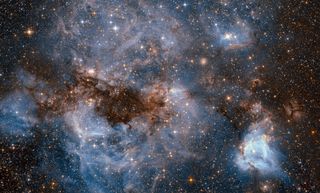Hubble Telescope Captures Jaw-Dropping Beauty of Nearby Galaxy

A spectacular new image captured by the Hubble Space Telescope shows bright-blue wisps of glowing gas and hot, sparkling, young stars within a satellite dwarf galaxy known as the Large Magellanic Cloud (LMC).
The LMC is one of the smaller satellite galaxies that orbit the Milky Way, and it's among a collection of galaxies known as the local group. It is one of the closest galaxies to Earth, at about 163,000 light-years away.
This dazzling new Hubble image peers into a stellar nursery known as N159, which measures more than 150 light-years across and houses many hot, newborn stars. [Hubble in Pictures: Astronomers' Top Picks (Photos)]
"These stars are emitting intense ultraviolet light, which causes nearby hydrogen gas to glow, and torrential stellar winds, which are carving out ridges, arcs and filaments from the surrounding material," Hubble researchers said in a statement when debuting the photo.
Within this stellar nursery lies a butterfly-shaped cosmic cloud known as the Papillon Nebula. The region consists of vast amounts of dense gas that give way to the birth of new stars.
N159 is located south of the Tarantula Nebula, which is designated heic1402 — another region known for massive star birth within the LMC. The Tarantula Nebula is located 170,000 light-years from Earth and is believed to house hundreds of thousands of stars. Inside the Tarantula Nebula lies an incredibly bright region known as 30 Doradus, which is considered a hotspot for star formation, according to the statement, released jointly by NASA and the European Space Agency.
Get the Space.com Newsletter
Breaking space news, the latest updates on rocket launches, skywatching events and more!
This beautiful new image, one of many taken by the Hubble telescope, was captured using Hubble's Advanced Camera for Surveys.
Follow Samantha Mathewson @Sam_Ashley13. Follow us @Spacedotcom, Facebook and Google+. Original article on Space.com.
Join our Space Forums to keep talking space on the latest missions, night sky and more! And if you have a news tip, correction or comment, let us know at: community@space.com.

Samantha Mathewson joined Space.com as an intern in the summer of 2016. She received a B.A. in Journalism and Environmental Science at the University of New Haven, in Connecticut. Previously, her work has been published in Nature World News. When not writing or reading about science, Samantha enjoys traveling to new places and taking photos! You can follow her on Twitter @Sam_Ashley13.
